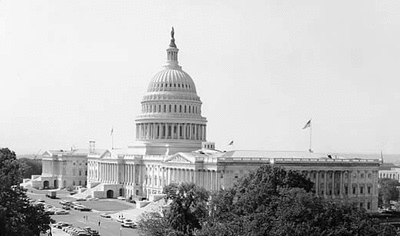I recently had a conversation with some fellow tour guides about the changes to the Capitol in the 1950s. I was going to send them a link to this, but could not find it on our web site. So here’s either a rerun, or a first run, article.
The United States Capitol has been a work in progress since the day that George Washington laid its cornerstone in 1793. Major changes included the rebuilding thereof after the British burned it in 1814, the massive wings on the north and south side, the dome – which was added during the Civil War – and, of course, the visitors center under the east plaza.
One of the changes, however, is difficult to visualize, as it did not actually change the exterior that much – from certain angles.
The massive dome added to the Capitol between 1855 (when President Pierce signed the appropriation for it) and 1866 (when Constantino Brumidi removed the last scaffolding he had been using to paint the inside) immediately became a striking addition to the skyline of Washington DC, and a powerful symbol for the work of government that went on inside.
It had a secondary effect on the building to which it was added: Overwhelming the original architecture of the east front. Architects complained about the ‘massing’ and how the front needed to be ‘visually strengthened’ but nothing came of it, though in 1904, the architectural firm of Carrere and Hastings worked together with the current Architect of the Capitol to plan a new addition that would rectify this deficiency. Nothing came of this work (though Wikipedia – and thus other sources – is convinced that this work actually happened) and it was not until 1958 that, finally, work began.
The design chosen was by one Alfred Easton Poor, and it not only improved the architecture, but also allowed for considerably more space for Congress, something they always seem to be short of. Over the next six years, the Capitol’s east front was under construction, and, when completed, it…didn’t look as if much had changed. In fact, other than that the facade was now entirely of marble, rather than sandstone, the facade, when viewed from, say, East Capitol Street, was almost exactly the same as before.
It is only when comparing two pictures thoughtfully provided by the Architect of the Capitol on his website that the differences can be seen. The pictures are taken from the northeast of the Capitol (presumably the Methodist building, though no details are given) and show the building in 1956, before work began, and 1961, when the exterior work was substantially done. I have merged these two buildings into an animated gif above, and here, finally, it is easy to see the east front – at least that which is not part of the two massive wings north and south – lurch forward 33 or so feet.
The full story of East Front was not completed until 1984, when the old columns, which had been added to the Capitol in 1828, were re-erected in the National Arboretum, a few miles northeast of the Capitol, where they continue to welcome visitors and teach them about the history of the Capitol from which they come.


